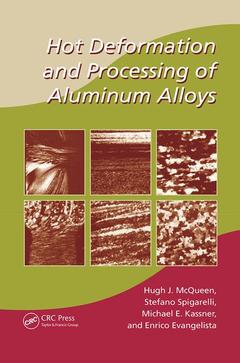Description
Hot Deformation and Processing of Aluminum Alloys
Manufacturing Engineering and Materials Processing Series
Authors: McQueen Hugh J., Spigarelli Stefano, Kassner Michael E., Evangelista Enrico
Language: English
Subjects for Hot Deformation and Processing of Aluminum Alloys:
Keywords
Subgrain Size; Al Alloys; strain; Strain Rate; rate; Eq Ui Va Len; subgrain; FCC Metal; size; Dislocation Density; work; DRX Grains; dislocation; Hot Working; density; Strain Hardening; cold; CW; working; GB; elongate; Slip Systems; Continuous DRX; Dense Dislocation Wall; Deformation Temperature; Constant Strain Rate; Elongated Grains; Plane Strain Compression; ASM International; Deformation Zone; Dislocation Pipe Diffusion; Monkman Grant Relationship; Strain Rate Sensitivity; Indirect Extrusion; Steady State Creep
120.12 €
In Print (Delivery period: 14 days).
Add to cartPublication date: 04-2017
· 15.6x23.4 cm · Paperback
305.19 €
In Print (Delivery period: 15 days).
Add to cartPublication date: 10-2011
· 15.6x23.4 cm · Hardback
Description
/li>Contents
/li>Readership
/li>Biography
/li>
A comprehensive treatise on the hot working of aluminum and its alloys, Hot Deformation and Processing of Aluminum Alloys details the possible microstructural developments that can occur with hot deformation of various alloys, as well as the kind of mechanical properties that can be anticipated. The authors take great care to explain and differentiate hot working in the context of other elevated temperature phenomena, such as creep, superplasticity, cold working, and annealing. They also pay particular attention to the fundamental mechanisms of aluminum plasticity at hot working temperatures.
Using extensive analysis derived from polarized light optical microscopy (POM), transmission electron microscopy (TEM), x-ray diffraction (XRD) scanning electron-microscopy with electron backscatter imaging (SEM-EBSD), and orientation imaging microscopy (OIM), the authors examine those microstructures that evolve in torsion, compression, extrusion, and rolling. Further microstructural analysis leads to detailed explanations of dynamic recovery (DRV), static recovery (SRV), discontinuous dynamic recrystallization (dDRX), discontinuous static recrystallization (dSRX), grain defining dynamic recovery (gDRV) (formerly geometric dynamic recrystallization, or gDRX), and continuous dynamic recrystallization involving both a single phase (cDRX/1-phase) and multiple phases (cDRX/2-phase).
A companion to other works that focus on modeling, manufacturing involving plastic and superplastic deformation, and control of texture and phase transformations, this book provides thorough explanations of microstructural development to lay the foundation for further study of the mechanisms of thermomechanical processes and their application.
Aluminum and Its Alloys. Metal Forming and Deformation Modes. Hot Work Testing Techniques. Hot Working of Aluminum. Hot Working of Dispersoid and Solute Alloys. Precipitation Hardening Alloys. Aluminum Matrix Composites. Comparison of Hot Working of other Metals. Creep: Strain Rates below 10−4 s−1. Cold Working. Static Restoration, Annealing. Thermomechanical Processing. Superplasticity. Extrusion. Rolling. Hot and Cold Forging.
Hugh J. McQueen is professor emeritus of materials and manufacturing in mechanical engineering at Concordia University and has served one term as the department chair. Since 1965, he has been conducting hot working research in industrial alloys of Al, Cu, Ni and Fe with special emphases on Al alloys and composites and on stainless steels. He has broadened his experience with sabbatical leaves at Comalco and BHP Research Centers (Melbourne), Norwegian Institute for Technology (Trondheim), Universities of Ancona, Erlangen-Nürnberg and Hamburg-Harburg. Professor McQueen also has taught undergraduate and graduate courses in mechanical properties and forming technology and has produced a short film on Dislocations. Before coming to Concordia in 1968, he had conducted research at CANMET and been associate professor at Ecole Polytechnique, Montreal. In 1961, he obtained his Ph.D. in Metallurgy from Notre Dame University (Indiana), following a B.Eng from McGill University in 1956 and a B.Sc from Loyola of Montreal in 1954. He is a fellow of Canadian Institute of Metallurgy, the Institute of Metals, Materials and Minerals the American Society for Metals and of the Canadian Society for Mechanical Engineering. In 2000, he received the Alcan Award in recognition of research and education contributions. From 1986 to 1998, Dr. McQueen served the Metallurgical Society CIM as a member of the Board and as chairs of the Microstructural Science Section and of the Metal Fabrication Section. He organized the International Conference on Strength of Metals and Alloys in Montreal in 1985 and served on its advisory council.
Prof. Stefano Spigarelli has been a professor of metallurgy on the engineering faculty at Università Politecnica delle Marche, Ancona, Italy, since April 2005. His research activity is mainly focused on the high-temperature mechanical properties of light metals and steels. His current interests include creep and hot working of




